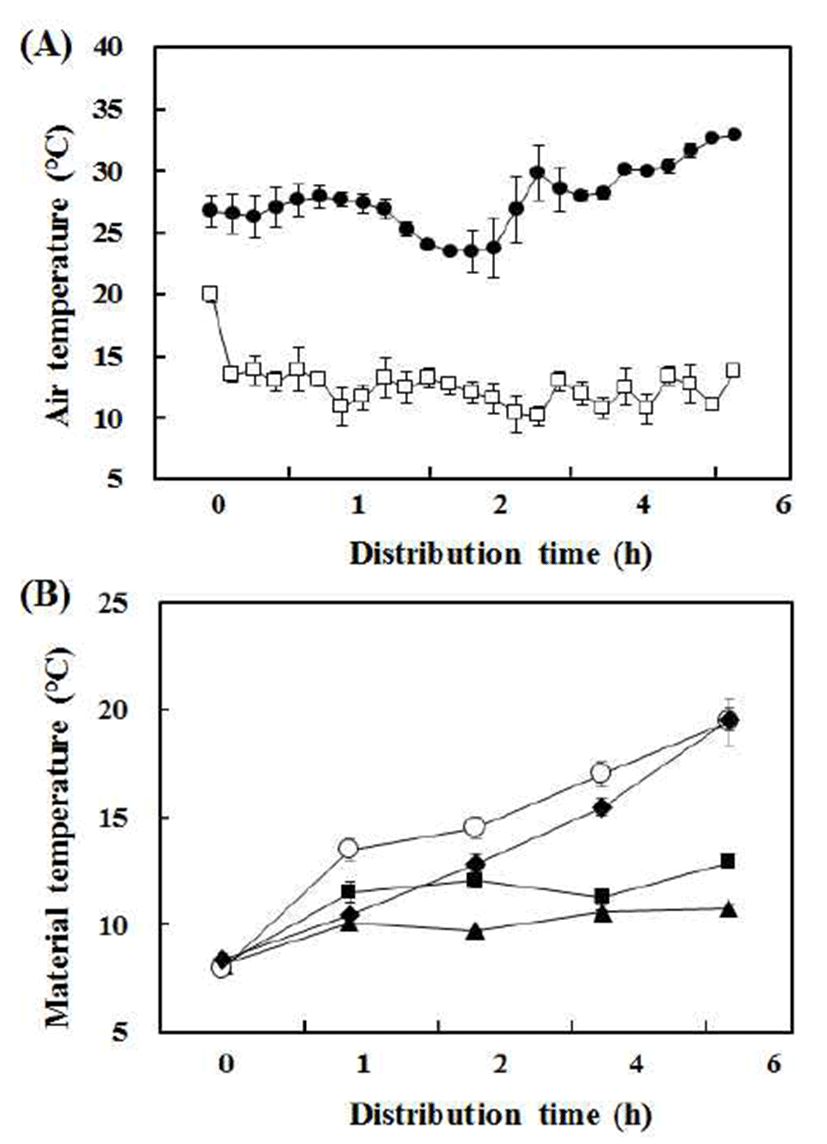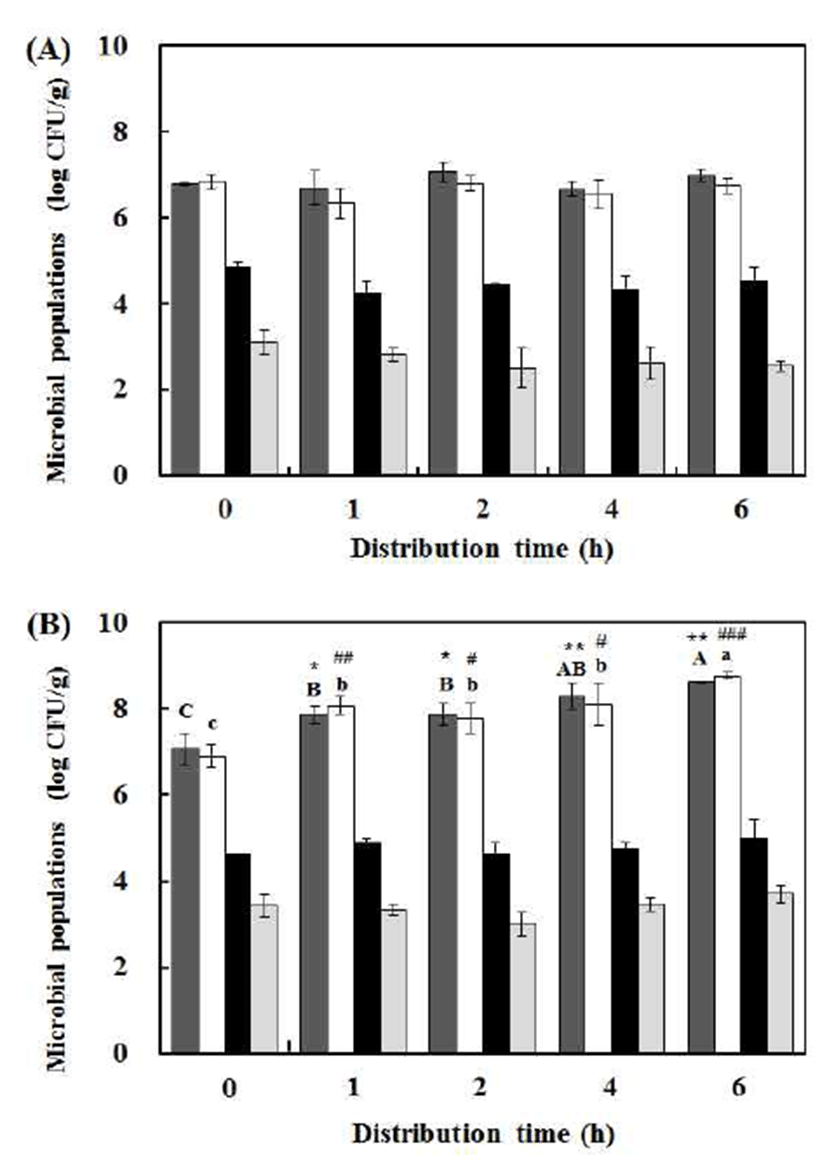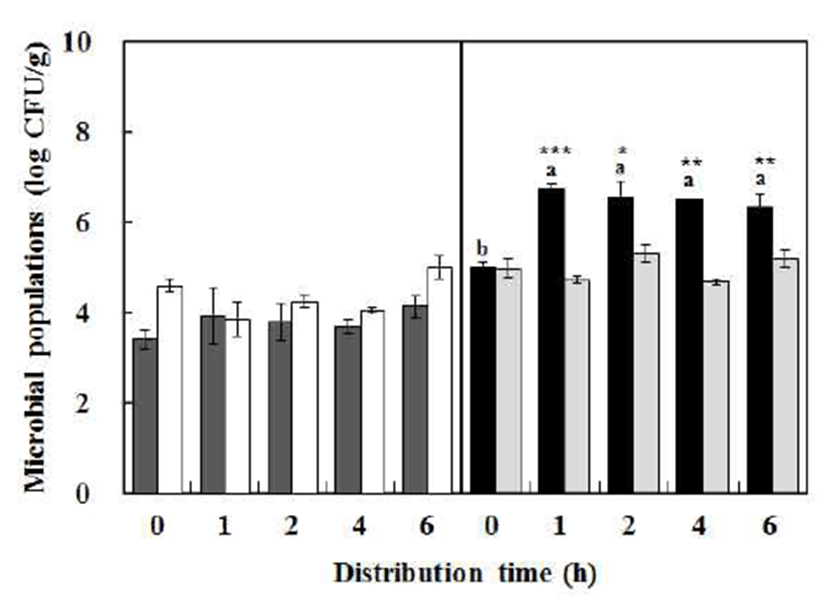Introduction
Kimchi is widely known as a traditional Korean fermented food manufactured by fermenting salted vegetables with probiotic lactic acid bacteria (LAB), which contribute to various functionalities of kimchi (1,2). Kimchi, a healthy probiotic food, is classified into hundreds of varieties based on the major raw materials and preparation methods. These varieties contain high levels of vitamins, minerals, dietary fiber and other functional components such as capsaicin, allyl compounds, and isothiocyanate (3). To manufacture Korean cabbage kimchi, the following several processes are required: the Korean cabbage is trimmed, washed, brined, rinsed, and excess water is drained off, and it is mixed with ingredients and kimchi seasoning (4). Recently, the manufacture and sale of salted Korean cabbage has been rapidly increasing to reduce the manufacturing process of kimchi. Generally, salted Korean cabbages in Korea are packaged using a low density polyethylene (LDPE) film and a cardboard box, and then they are stored in a refrigerated condition. The LDPE film has excellent flexibility and transparency; therefore, it is very useful as a kimchi packaging material.
A variety of approaches have been studied to extend the shelf-life and to maintain the quality of salted Korean cabbage during storage. A combination of vacuum cooling and low temperature distribution using a cold-chain system for extending the shelf-life was studied (5). Mirafresh film, was found to be the most suitable packaging material for a long-term storage of salted Korean cabbage (6,7). It is known that a 10% salt water solution is the optimal concentration for maintaining the quality of salted cabbage (6). Lee et al. (2011) reported that treatments such as pressurization, decompression, and steaming are used for the treatment of salting Korean cabbage. In order to preserve the quality of salted Korean cabbage during storage, ozone treatment (9) and electrolyzed water (EW) washing of the cabbage were performed before the salting process (10). Microbial risk factors in the facilities and materials used for the processing of salted Korean cabbage (11) and the risk associated with fresh and salted Korean cabbage have been reported (12). Jung et al. (2011) reported about microbiological changes in salted Korean cabbage during the recycling brine operation by polymerase chain reaction-denaturing gradient gel electrophoresis (PCR-DGGE). Inoculation of halophilic Lactobacillus was attempted to extend the preservation period (14) and to improve the quality of fermented Korean cabbage through the selected starter culture (15). In addition, there have been reports describing the quality characteristics of salted Korean cabbage under the different temperature conditions during storage (16,17). However, we could not find any research on the characteristics of salted Korean cabbage related to the distribution. Therefore, we aimed to provide a quality index of salted Korean cabbage, as well as to investigate the quality changes using different packaging methods in the short-term distribution system.
Materials and Methods
Korean cabbage Brassica rapa L. ssp. pekinensis var. ‘Chun-Gwang’ was used in this study. Salted Korean cabbages were purchased from Wangin food (Yeongam, Korea) in August 2015. Salted Korean cabbage production was performed through the step of soaking in salt water. Korean cabbages of uniform size were selected, trimmed and cut in half, and were soaked in 7% (w/v) of natural sea salt water for 16 h at room temperature. Salted Korean cabbages were washed three times to remove the salt, and then drained for 3 h at room temperature.
Purified salt was obtained from the local market (Hanju Co., Ulsan, Korea). Salt water used in this research for packaging was made by adding purified salt in water at a final concentration of 2% (w/v). Ten kilograms of salted Korean cabbages (cut in half) were wrapped with a LDPE film with or without salt water. Then, each sample was packaged in a plastic box with the same amount of salt water and distributed in a CVS or a CCS for 6 h.
A temperature logger (Testo 175 T3, Germany; EBI20- TH1, WTW GmbH Geschäftsbereich ebro Electronic) was used to measure the air temperature inside the cargo container in a truck. A thermometer (Testo 103, Germany) was used to assess the material temperature of salted Korean cabbage.
Half of the salted Korean cabbage (0.72-0.81 kg) was ground using a hand-held blender (HR1372, Koninklijke Philips N.V., Netherlands), diluted with distilled water (1:100, v/v), and filtered through a filter paper (Hyundai Micro Co., Ltd., Korea). Then, 10 mL of the filtered solution was titrated with 0.02 N AgNO3 solution followed by the addition of 1 mL of 2% K2CrO4 solution, which was used as an indicator through the appearance of red-brown precipitates during silver nitrate titration (18).
The pH of ground samples was measured using a digital pH meter (Titroline easy module 2, SI Analytics GmbH, Germany) at 20±0.5℃ after homogenization. Then, 20 mL of the filtrate was measured until the pH reached 8.3 by adding 0.1N NaOH, and was expressed as % total acid. The measured volume was then substituted into the following equation for obtaining the titratable acidity value (19): Titratable acidity (%)=Volume of 0.1 N NaOH (mL)×Normality of NaOH×lactic acid factor/Weight of the sample (g)
The moisture content in a total of 3 g of each ground sample was measured with an infrared drying moisture analyzer (MB45, Ohaus, Germany).
A total of 10 g of the homogenized sample was transferred to a sterile stomacher filter followed by the addition of 90 mL of 0.85% of saline water before mixing in a Stomacher (Bagmixer R400, Interscience, Saint Nom, France) for 1 min. Appropriate decimal dilution was performed in duplicate in aerobic count plates (3MTM PetrifilmTM Aerobic Count Plates, 3M Co., St. Paul, MN, USA), MRS (DifcoTM Lactobacilli MRS broth, Sparks, MD, USA) plates supplemented with 25 ppm of Bromocresol purple (B0501, SAMCHUN PURE CHEMICAL Co., Ltd., Pyeongtaek, Korea), E. coli/Coliform count plates (3MTM PetrifilmTME. coli/Coliform count plates, 3M Co.), and yeast and mold count plates (3MTM PetrifilmTM Yeast and Mold Count Plates, 3M Co.). Total aerobic bacteria, lactic acid bacteria, E. coli, and coliforms were incubated at 35℃ for 48 h, respectively. Yeast and molds were incubated at 30℃ for 48 h Each microbial count was expressed as log CFU/g.
All experiments were performed in triplicate. The results are presented as the mean value±SD and were subjected to statistical analysis with SPSS ver. 19.0 (SPSS Inc., Chicago, IL, USA). One-way ANOVA (one-way analysis of variance) and Duncan’s multiple range comparison were used to identify significant differences (p<0.05). Pearson’s correlation coefficients were used to determine the correlation coefficient (r) between each of the parameters and the transport system.
Results and Discussion
Salted Korean cabbage distributed using the CCS after packaging with a LDPE film without salt water was used as a control. Changes in air temperature and material temperature inside the cargo container are displayed in Fig. 1. During distribution in the summer season using a CVS without air-cooling in the truck, a continuous increase in the air temperature from 26.7℃ to 32.9℃ was observed. However, with the CCS, temperature distribution from 10.1℃ to 13.8℃ was recorded. The internal temperature decreased to 13.5℃ within 10 minutes of starting the operation, with an initial temperature of 10℃ (Fig. 1A). The material temperature of salted Korean cabbages was measured using a thermometer (Fig. 1B). The material temperature of salted Korean cabbage with or without salt water gradually increased from 8.13℃ to 10.73℃ or from 8.13℃ to 12.90℃ in a CCS, respectively. An apparent change in the material temperature according to the increase in the air temperature was observed with both packaging types used for distribution in a CVS (from 7.90℃ to 19.43℃ in LDPE packaging without salt water, and from 8.33℃ to 19.57℃ in LDPE packaging with salt water). The increasing pattern of the material temperature was found to be dependent on changes in both transport systems. In addition, the temperature-rise ratio for salted Korean cabbages packaged without salt water was higher than that for salted Korean cabbages packaged with salt water. These results suggest that the storage type and air temperature during distribution can affect the quality of salted Korean cabbage.

To determine the physicochemical quality index, moisture content, relative salinity, acidity, and pH were analyzed (Table 1). The moisture content measured in all samples ranged from 90.3% to 93.0%. No significant differences were observed in moisture content between the control and the sample during distribution for 6 h. Salt type (20), salting method (8,20), salting time, and salt concentrations (8,16,17,20) can affect the salinity of salted Korean cabbage immediately after the salting process. Therefore, the salting ratios of salted Korean cabbages manufactured as commercial goods are quite different. To determine the normalized quality index of salinity, the variation rate of salinity was expressed as the relative ratio (%). The relative salinity of salted Korean cabbages distributed using a CCS showed some minor changes. However, with use of a CVS, salted Korean cabbages without salt water had a significantly higher salinity rate at 6 h compared with the control (1.72±0.11, p<0.05). Salted Korean cabbages with salt water also showed a similar pattern, but the salinity was not as severe as that of the sample without salt water. These results are consistent with the changing pattern of temperature, as shown in Fig. 1, demonstrating that changes in air temperature during distribution affect the salting ratio of Korean cabbage, similar to that observed in the previous reports (16,17).
It has been reported that the rate of pH reduction, chemical changes, and microbial populations in kimchi are dependent on the temperature (20-22). Table 1 presents the results for the acidity and pH of salted Korean cabbages. During distribution by the CCS, a significant pH change was not observed, whereas the acidity was slightly increased (from 0.19 to 0.32 in LDPE packaging without salt water, and from 0.19 to 0.27 in LDPE packaging with salt water). However, in a CVS, there was no significant difference in the pH and acidity between the control and the samples. The initial acidity was calculated to be less than 0.2 in all samples. The maximum acidity detected in this experiment was 0.32. These minor changes in pH and acidity during distribution for 6 h in both systems might be due to the short amount of time allotted for changes to occur in salted Korean cabbage.
The microbial populations in salted Korean cabbages were analyzed. Fig. 2 shows the microbial counts of aerobic bacteria (AB), lactic acid bacteria (LAB), coliform bacteria (CB), and yeast and mold (YM). There was no significant change in microbial counts in salted Korean cabbage packaged without salt water (Figure 2A), whereas the initial community of AB (6.86 log CFU/g) and LAB (6.06 log CFU/g) in the packaging with salt water increased by approximately 1 log CFU/g within 1 h compared with the control, which showed values of 5.66 log CFU/g for aerobic bacteria and 4.90 log CFU/g for LAB (Fig. 2B). Also, we confirmed that this proliferation of the populations relative to time was statistically significant. Through these results, we confirmed that constant temperature increase in a cargo container can affect the growth of AB and LAB in salted Korean cabbage packaged with salt water. The populations of these two bacteria in salted Korean cabbage under the CCS were investigated (Fig. 3). AB and LAB counts were not significantly different before and after distribution in this system (Fig. 3). These findings suggest that the microbiological quality is subject to the packaging type and temperature in salted Korean cabbage distribution. AB and LAB showed rapid proliferation with an increase in the material temperature in salted Korean cabbage packaged with salt water in a CVS. These results suggest that salinity, aerobic bacteria and lactic acid bacteria can be useful as quality indicators during distribution.

 , Aerobic bacteria; □, Lactic acid bacteria; ■, Coliform bacteria;
, Aerobic bacteria; □, Lactic acid bacteria; ■, Coliform bacteria;  Yeast and mold.
Letters above bars indicate statistically significant differences by the Duncan’s multiple range test (p<0.05). Marks denote statistical significance at *p<0.05 and **p<0.01, control vs. case of aerobic bacteria; #p<0.05, ##p<0.01, and ###p<0.01, control vs. case of lactic acid bacteria using student’s t-test. All values are mean±SD (n=3).
Yeast and mold.
Letters above bars indicate statistically significant differences by the Duncan’s multiple range test (p<0.05). Marks denote statistical significance at *p<0.05 and **p<0.01, control vs. case of aerobic bacteria; #p<0.05, ##p<0.01, and ###p<0.01, control vs. case of lactic acid bacteria using student’s t-test. All values are mean±SD (n=3).

 , AB from CCS-LDPE; □, AB from CCS-LDPE with brine; ■, LAB from CCS-LDPE;
, AB from CCS-LDPE; □, AB from CCS-LDPE with brine; ■, LAB from CCS-LDPE;  LAB from CCS-LDPE with brine.
Means with different letters above a bar are significantly different at p<0.05. All error bars are mean±SD (n=3).
LAB from CCS-LDPE with brine.
Means with different letters above a bar are significantly different at p<0.05. All error bars are mean±SD (n=3).
To determine and validate the quality index for the distribution of salted Korean cabbage, a correlation analysis was conducted (Table 2). The temperature changes in the materials used in this study were dependent on the transport system and the packaging type (Fig. 1). Also, the material temperature affected the quality characteristics such as salinity, acidity (Table 1), AB and LAB (Fig. 2 and 3), which was similar to that observed in previous reports on kimchi fermentation (21), and low storage temperature (10). Therefore, we analyzed the Pearson’s correlation coefficient (23,24) between the temperature changes in the materials according to the transport system and the quality characteristics to determine the quality index for the distribution of salted Korean cabbage (Table 2). The correlation coefficients between a CVS without salt water and salinity, acidity, or yeast and mold were 0.89, 0.55 and -0.55, respectively. In the case of a CVS with salt water, positive and strong correlation values of 0.79, 0.88, and 0.81 were obtained for salinity, AB, and LAB, respectively. The correlation between this transport system and pH was -0.74. A significant and strong statistical correlation between a CVS and salinity in the LDPE packaging with or without salt water described in Table 2 suggests that salinity changes in salted Korean cabbage are closely associated with changes in the material temperature. These results also support the observations presented in previous reports (10,21,22).
In the CCS without salt water, the correlation of acidity was calculated to be 0.68. Also, positive correlations between the CCS with salt water and acidity or pH were detected in accordance with the derived values of 0.72 and 0.61. There was no statistically significant correlation between the CCS and moisture content, AB, or LAB in either of the packaging methods (Table 2). However, the two different packaging methods in this system showed high correlations with acidity. Based on these results, we determined the quality index of salted Korean cabbage. During distribution using a CVS, the most important quality index for salted Korean cabbage packaged with or without salt water is salinity. In the case of salted Korean cabbage packaged with salt water, AB, LAB, and pH are useful as quality indices. During distribution using a CCS with the two packaging types mentioned above, the most important quality index is salinity.
To examine the effect of the two different distribution systems, the physicochemical and microbiological characteristics of salted Korean cabbage were measured. During distribution, salted Korean cabbage which was distributed in a CVS had a higher material temperature and salting ratio than that distributed in a CCS. A slight acidity change was observed in salted Korean cabbage which was distributed in a CCS. The number of total aerobic bacteria and lactic acid bacteria was 5.62-5.85 log CFU/g and 4.33-4.83 log CFU/g, respectively, immediately after packaging, but it reached to 7.62 log CFU/g and 6.77 log CFU/g, respectively, in the salt water packaging product in a CVS. Thus, the CCS with salt water packaging was effective in achieving microbial control and maintaining physicochemical quality of salted Korean cabbage. According to the results of the correlation analysis to determine the quality index for both systems, salinity, aerobic bacteria and lactic acid bacteria appeared to be useful as quality indices for CVS, and acidity appeared to be useful as quality index for CCS. Although the shelf-life of salted Korean cabbage was not determined in this study, our findings provided quality indicators for quality prediction of salted Korean cabbage which was distributed with two different storage conditions by alternating temperatures in the summer season. In addition, our results will be useful for the quality evaluation and safety assessment of fermented vegetables such as radish and cucumber as well as salted Korean cabbages during short-term distribution.
요 약
본 연구는 절임배추의 유통 중 단기 유통시스템에 따른 이화학적 및 미생물학적 품질 변화에 대하여 알아보고, 그 에 따른 품질지표를 평가하고자 실시하였다. 여름철에 제 조한 절임배추는 탈수 후 바로 저밀도 폴리에틸렌 필름에 포장하거나 2% 염수와 함께 포장하여 실온유통시스템 (conventional system)과 저온유통시스템(cold-chain system) 을 갖춘 1톤 트럭에 각각 구분하여 적재하였으며 약 6시간 동안 유통하였다. 이화학적 및 미생물학적 변화로 품온, 염도, 산도, pH, 수분감, 일반세균, 젖산균, 대장균, 대장균 군, 효모 및 곰팡이에 대해 조사하였다. 실온유통시스템의 경우 절임배추의 품온은 필름 내 염수포장 절임배추에서 19.57℃, 필름포장 절임배추에서 19.43℃, 저온유통시스템 의 경우 필름 내 염수포장 절임배추에서 10.73℃, 필름포장 절임배추에서 12.90℃까지 증가하였다. 염도변화는 저온유 통시스템의 경우 변화가 없었으나, 실온유통시스템의 경우 필름 내 염수포장 절임배추와 필름포장 절임배추에서 품온 과 각각의 염도변화가 정의 상관성을 보이며 초기에 비해 1.2배 혹은 1.7배 더 높았다. 산도는 저온유통시스템에서 두 가지 포장조건 모두 약간 증가하였다. 실온유통시스템 에서 필름 내 염수포장 절임배추의 총 호기성균과 젖산균 수가 각각 7.62 log CFU/g 및 6.77 log CFU/g까지 증가하는 동안 필름포장 절임배추는 각각 5.62-5.85 log CFU/g과 4.33-4.83 log CFU/g의 범위를 나타냈다. 그러나 저온유통 시스템의 경우 유통시간 증가에 따른 유의미한 미생물학적 변화를 보이지 않았다. 따라서 절임배추 유통 시 저온유통 시스템을 이용한 경우 이화학적 품질 유지 및 미생물 제어 에 효과적이며, 실온유통시스템을 이용한 경우 품온 상승 에 따른 염도 및 미생물 변화에 유의해야 한다. 또한 염도, 총호기성균 및 젖산균은 실온유통시스템 내 품질지표로 이용가능하며, 산도는 저온유통시스템 내 품질지표로 이용 가능하다.